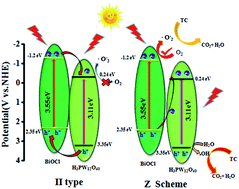Facile synthesis of a direct Z-scheme BiOCl–phosphotungstic acid heterojunction for the improved photodegradation of tetracycline†
Abstract
The fabrication of a Z-scheme heterojunction photocatalyst can effectively modulate the electron transfer and separation of photoinduced charge carriers to enhance photocatalytic performance. Here, we demonstrate a direct Z-scheme BiOCl–phosphotungstic acid (BiOCl–HPW) heterojunction, fabricated via a one-step hydrothermal synthesis, as a highly active and stable photocatalyst for the photodegradation of tetracycline. BiOCl–HPWs result in a dramatic improvement in visible-light utilization and photogenerated e− and h+ separation, as well as a decrease in the electrical resistance by the addition of HPW. Notably, the BiOCl–HPW heterojunction with optimized phosphotungstic acid (HPW) content achieved an outstanding photodegradation rate of tetracycline (0.0195 min−1). A reasonable Z-scheme photocatalytic mechanism based on the analysis of band structure and monitoring of active radicals is proposed. This study highlights the potential implications of the BiOCl–HPW heterojunctions in the photodegradation of other toxic chemicals and photocatalytic studies.



 Please wait while we load your content...
Please wait while we load your content...